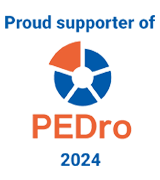Ocena funkcjonalna i posturograficzna pacjentów poddanych usprawnianiu rehabilitacyjnemu z powodu gonartrozy – Amanda Maria Kostro

Prezentujemy streszczenia (w jęz. polskim oraz j. angielskim) prac naukowych nadesłanych w ramach konkursu na najlepsze wystąpienie dotyczące interdyscyplinarności w fizjoterapii podczas II kongresu KIF.

W kategorii „WYSTĄPIENIA USTNE. Sesja dla młodych pracowników nauki, doktorantów i fizjoterapeutów w trakcie specjalizacji w dziedzinie fizjoterapia”
– 3 miejsce ex aequo zajęła dr Amanda Maria Kostro
Tytuł: Ocena funkcjonalna i posturograficzna pacjentów poddanych usprawnianiu rehabilitacyjnemu z powodu gonartrozy
Autorzy: dr Amanda Maria Kostro¹, prof. Anna Kuryliszyn – Moskal¹, dr hab. Zofia Dzięcioł – Ankiel¹
¹ Klinika Rehabilitacji, Wydział Nauk o Zdrowiu, Uniwersytet Medyczny w Białymstoku
STRESZCZENIE
Wprowadzenie: Gonartroza jest jedną z przyczyn niepełnosprawności. Obok patologicznych procesów w układzie kostno-stawowym istotnym problemem są zaburzenia równowagi i stabilności związane z utratą propriocepcji i wzrostem ryzyka upadków. Zmiany zwyrodnieniowe powodują zmniejszenie siły mięśniowej, pogorszenie propriocepcji, biomechaniki oraz stabilności postawy. Ponadto deficyt proprioceptywny może być spowodowany urazami chrząstki stawowej [1,2]. Rozwój technologii i powszechne zastosowanie sztucznej inteligencji pozwala na wprowadzenie obiektywnych i dokładnych rozwiązań w terapii i diagnostyce zaburzeń równowagi. Najlepszym tego przykładem jest badanie posturograficzne. Systematyczne przeglądy piśmiennictwa i metaanalizy wskazują na możliwość zastosowania ćwiczeń równoważnych i siłowych u pacjentów z gonartrozą [3].
Cel: Ocena wpływu programu rehabilitacji uwzględniającego medyczny trening oraz wkładki ortopedyczne przy pomocy badania klinicznego i posturograficznego na funkcjonalność osób z gonartrozą.
Materiał i metody: Spośród uczestników (n=166) wyodrębniono dwie grupy – kontrolną (n=41) i badaną, w której dokonano losowego przydziału do jednej z trzech grup – ,,Wkładki” (n=43), ,,Ćwiczenia” (n=43), ,,Wkładki i ćwiczenia” (n=39). Kryteria włączenia do programu obejmowały rozpoznanie lekarskie obustronnej choroby zwyrodnieniowej stawów kolanowych zlokalizowanej w przedziale przyśrodkowym. Kryteria wykluczenia obejmowały urazy lub interwencje chirurgiczne wpływające na zaburzenia równowagi. Do oceny równowagi i rehabilitacji użyto testów funkcjonalnych (test chodu na dystansie 10 m, Up and Go, stania jednonóż, Step test, Five Time Sit to Stand Test, skala Berga), a dla jakość życia kwestionariusza KOOS. Wykonano również badanie posturograficzne na macie tensometrycznej przy pomocy Testu Romberga i Testu Wychwiań. Diagnostykę przeprowadzono dwukrotnie – przed i po 6 tygodniowej terapii. Uzyskane dane poddano ocenie statystycznej przy pomocy testów: Manna-Whitneya, kolejności par Wilcoxona Kruskala – Wallisa oraz Spearmana. Za poziom istotności przyjęto p=0,05.
Wyniki: Uzyskano istotne statystycznie różnice w ocenie funkcjonalnej i posturograficznej pacjentów w porównaniu do osób z grupy kontrolnej (p<0,05), a także wykazano korzystny efekt przeprowadzonej terapii (p<0,05). Największą skuteczność uzyskano w grupie osób wykonujących ćwiczenia i stosujących jednocześnie wkładki ortopedyczne.
Wnioski: U pacjentów z chorobą zwyrodnieniową stawów kolanowych występują deficyty równowagi widoczne w testach posturograficznych i klinicznych, a zastosowanie rehabilitacji pozwala na ich redukcję.
Finansowanie: Projekt nie był finansowany ze źródeł zewnętrznych.
Słowa kluczowe: wkładki ortopedyczne, core, trening, rehabilitacja, kolano, gonartroza, równowaga, posturografia
* * *
Title: Functional and posturographic assessment of patients undergoing rehabilitation rehabilitation due to gonarthrosis
Authors: dr Amanda Maria Kostro¹, prof. Anna Kuryliszyn – Moskal¹, dr hab. Zofia Dzięcioł – Ankiel¹
¹ Rehabilitation Clinic, Faculty of Health Sciences, Medical University of Bialystok
ABSTRACT
Background: Gonarthrosis is one of the causes of disability. In addition to pathological processes in the skeletal and joint system, an important problem is balance and stability disorders associated with loss of proprioception and an increase in the risk of falls. Degenerative changes cause reduced muscle strength, deterioration of proprioception, biomechanics and postural stability. Moreover, proprioceptive deficit may be caused by injuries to the articular cartilage [1,2]. The development of technology and the widespread use of artificial intelligence allows for the introduction of objective and accurate solutions in the therapy and diagnosis of balance disorders. The best example of this is posturography. Systematic literature reviews and meta-analyses indicate the possibility of using balance and strength exercises in patients with gonarthrosis [3].
Aim: Assessing the impact of a rehabilitation programme that includes medical training and orthopedic insoles at clinical and posturographic examination on the basis of functionality of people with osteoarthritis.
Material and methods: Of the participants (n=166), two groups – the control group (n = 41) and the test group, in which randomly assigned to one of the three groups – “Insoles” (n=43), “Exercises” (n=43), “Insoles and exercises” (n=39). Criteria for inclusion in the scheme included medical diagnosis of bilateral degenerative disease knee joints located in the medial system. Exclusion criteria included injuries or surgical interventions affecting disorders Balance. Tests were used to assess balance and rehabilitation functional tests (gait test at a distance of 10 m, Up and Go, One-Legged Standing, Step test, Five Time Sit to Stand Test, Berg scale), and for the quality of life questionnaire KOOS. A posturographic examination was also performed on the strain gauge with the Romberg Test and the Stagger Test. The diagnostics were carried out twice – before and after 6 weeks of therapy. Data obtained was statistically evaluated by the following tests: MannaWhitney, the order of pairs Wilcoxon Kruskal – Wallis and Spearman. The significance level was p = 0.05.
Results: Obtaining a statistically significant difference in the functional and posturographic results of patients compared to those from the control groups (p<0.05), and the effect obtained in the treatment was also demonstrated (p<0.05). possibility of gaining access in a group of people performing exercises and additional orthopedic inserts.
Conclusion: In patients with sequelae of neurological treatment, side effects resulting from posturography tests and their use, and the use allows their use.
Funding: The project was not financed from external sources.
Key words: posturography, balance, gonarthrosis, knee, rehabilitation, training, core, orthopedic insoles
Piśmiennictwo/References:
1. Zeng Z, Shan J, Zhang Y, et al. Asymmetries and relationships between muscle strength, proprioception, biomechanics, and postural stability
in patients with unilateral knee osteoarthritis. Front Bioeng Biotechnol. 2022;10:922832,
2. Henry M, Baudry S. Age-related changes in leg proprioception:
implications for postural control. J Neurophysiol. 2019;122(2):525-538,
3. Prabhakar AJ, R S, Thomas DT, et al. Effectiveness of balance training on pain and
functional outcomes in knee osteoarthritis: A systematic review and meta-analysis. F1000Res. 2023;11:598.




